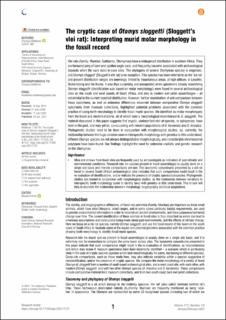| dc.contributor.author | Matthews, Thalassa | |
| dc.contributor.author | Nel, Turid Hillestad | |
| dc.date.accessioned | 2021-05-07T11:47:28Z | |
| dc.date.available | 2021-05-07T11:47:28Z | |
| dc.date.created | 2021-02-03T10:36:01Z | |
| dc.date.issued | 2021 | |
| dc.Published | South African Journal of Science. 2021, 117 (1/2), 82-90. | |
| dc.identifier.issn | 0038-2353 | |
| dc.identifier.uri | https://hdl.handle.net/11250/2754166 | |
| dc.description.abstract | Vlei rats (Family: Muridae; Subfamily: Otomyinae) have a widespread distribution in southern Africa. They are favoured prey of barn and spotted eagle owls, and frequently become associated with archaeological deposits when the owls roost in cave sites. The phylogeny of several Otomyinae species is enigmatic, and Otomys sloggetti (Sloggett’s vlei rat) is no exception. This species has been referred to as the ‘ice rat’ and present distribution ranges are seemingly limited to mountainous areas, at high altitude, in Lesotho Drakensberg and the Karoo. It was thus surprising and unexpected when specimens closely resembling Otomys sloggetti (identification was based on molar morphology) were found in several archaeological sites on the south and west coasts of South Africa, and also in modern owl pellet assemblages – all extralimital to the current reported distribution. However, further examination of and comparison between these specimens, as well as extensive differences observed between comparative Otomys sloggetti specimens from museum collections, highlighted potential problems associated with the common practice of using tooth morphology to identify fossil murid species. We identified six molar morphotypes from the fossil and modern material, all of which bore a morphological resemblance to O. sloggetti. The material discussed in this paper suggests that cryptic, undescribed vlei rat species, or subspecies, have been in the past, and may yet be, co-occurring with modern populations of O. karoensis and O. irroratus. Phylogenetic studies need to be done in conjunction with morphological studies, as, currently, the relationship between the huge variation seen in interspecific morphology with genetics is little understood, different Otomys species are not always distinguishable morphologically, and considerable chromosomal polytypes have been found. Our findings highlight the need for extensive cladistic and genetic research on the Otomyinae.
Significance:
Mice and shrews from fossil sites are frequently used by archaeologists as indicators of past climatic and environmental conditions. Research into the species present in fossil assemblages is usually done on a single site basis and intersite comparisons are rare. The taxonomic conundrums presented by a vlei rat found in several South African archaeological sites indicates that such comparisons could result in the re-evaluation of identifications, and/or indicate the presence of cryptic species/subspecies. Phylogenetic studies are needed in conjunction with morphological studies, as the relationship between variations in interspecific tooth morphology (used to identify taxa) with genetics is little understood. This in turn will help to elucidate the relationship between morphology, biogeography and local adaptations. | en_US |
| dc.language.iso | eng | en_US |
| dc.publisher | Academy of Science of South Africa | en_US |
| dc.rights | Navngivelse 4.0 Internasjonal | * |
| dc.rights.uri | http://creativecommons.org/licenses/by/4.0/deed.no | * |
| dc.title | The cryptic case of Otomys sloggetti (Sloggett’s vlei rat): Interpreting murid molar morphology in the fossil record | en_US |
| dc.type | Journal article | en_US |
| dc.type | Peer reviewed | en_US |
| dc.description.version | publishedVersion | en_US |
| dc.rights.holder | Copyright 2021. The Author(s). | en_US |
| cristin.ispublished | true | |
| cristin.fulltext | original | |
| cristin.qualitycode | 1 | |
| dc.identifier.doi | https://doi.org/10.17159/ sajs.2021/7137 | |
| dc.identifier.cristin | 1886232 | |
| dc.source.journal | South African Journal of Science | en_US |
| dc.source.40 | 117 | |
| dc.source.14 | 1/2 | |
| dc.identifier.citation | South African Journal of Science. 2021, 117 (1-2). | en_US |
| dc.source.volume | 117 | en_US |
| dc.source.issue | 1-2 | en_US |

